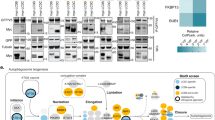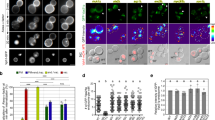Abstract
The Golgi-localized, γ-ear-containing, Arf-binding (GGA) proteins constitute a family of clathrin adaptors that are mainly associated with the trans-Golgi network (TGN)1,2,3 and mediate the sorting of mannose 6-phosphate receptors4,5,6. This sorting is dependent on the interaction of the VHS domain of the GGAs with acidic-cluster-dileucine signals in the cytosolic tails of the receptors4,5. Here we demonstrate the existence of another population of GGAs that are associated with early endosomes. RNA interference (RNAi) of GGA3 expression results in accumulation of the cation-independent mannose 6-phosphate receptor and internalized epidermal growth factor (EGF) within enlarged early endosomes. This perturbation impairs the degradation of internalized EGF, a process that is normally dependent on the sorting of ubiquitinated EGF receptors (EGFRs) to late endosomes. Protein interaction analyses show that the GGAs bind ubiquitin. The VHS and GAT domains of GGA3 are responsible for this binding, as well as for interactions with TSG101, a component of the ubiquitin-dependent sorting machinery. Thus, GGAs may have additional roles in sorting of ubiquitinated cargo.
This is a preview of subscription content, access via your institution
Access options
Subscribe to this journal
Receive 12 print issues and online access
$209.00 per year
only $17.42 per issue
Buy this article
- Purchase on Springer Link
- Instant access to full article PDF
Prices may be subject to local taxes which are calculated during checkout





Similar content being viewed by others
References
Boman, A.L., Zhang, C., Zhu, X. & Kahn, R.A. A family of ADP-ribosylation factor effectors that can alter membrane transport through the trans-Golgi. Mol. Biol. Cell. 11, 1241–1255 (2000).
Dell'Angelica, E.C. et al. GGAs: a family of ADP ribosylation factor-binding proteins related to adaptors and associated with the Golgi complex. J. Cell Biol. 149, 81–94 (2000).
Hirst, J. et al. A family of proteins with γ-adaptin and VHS domains that facilitate trafficking between the trans-Golgi network and the vacuole/lysosome. J. Cell Biol. 49, 67–80 (2000).
Puertollano, R., Aguilar, R.C., Gorshkova, I., Crouch, R.J. & Bonifacino, J.S. Sorting of mannose 6-phosphate receptors mediated by the GGAs. Science 292, 1712–1716 (2001).
Zhu, Y., Doray, B., Poussu, A., Lehto, V.P. & Kornfeld, S. Binding of GGA2 to the lysosomal enzyme sorting motif of the mannose 6- phosphate receptor. Science 292, 1716–1718 (2001).
Ghosh, P., Griffith, J., Geuze, H.J. & Kornfeld, S. Mammalian GGAs act together to sort mannose 6-phosphate receptors. J. Cell Biol. 163, 755–766 (2003).
Puertollano, R., Randazzo, P., Hartnell, L.M., Presley, J. & Bonifacino, J.S. The GGAs promote ARF-dependent recruitment of clathrin to the TGN. Cell. 105, 93–102 (2001).
Wasiak, S. et al. Enthoprotin: a novel clathrin-associated protein identified through subcellular proteomics. J. Cell Biol. 158, 855–862 (2002).
Mattera, R., Arighi, C.N., Lodge, R., Zerial, M. & Bonifacino, J.S. Divalent interaction of the GGAs with the Rabaptin-5–Rabex-5 complex. EMBO J. 22, 78–88 (2003).
Lui, W.W. et al. Binding partners for the COOH-terminal appendage domains of the GGAs and γ-adaptin. Mol. Biol. Cell 14, 2385–2398 (2003).
Puertollano, R. et al. Morphology and dynamics of clathrin/GGA1-coated carriers budding from the trans-Golgi network. Mol. Biol. Cell 14, 1545–1557 (2003).
Klumperman, J. et al. Differences in the endosomal distributions of the two mannose 6-phosphate receptors. J. Cell Biol. 121, 997–1010 (1993).
Futter, C.E., Pearse, A., Hewlett, L.J. & Hopkins, C.R. Multivesicular endosomes containing internalized EGF–EGF receptor complexes mature and then directly with lysosomes. J. Cell Biol. 132, 1011–1023 (1996).
Longva, K.E. et al. Ubiquitination and proteasomal activity is required for transport of the EGF receptor to inner membranes of multivesicular bodies. J. Cell Biol. 156, 843–854 (2002).
Bache, K.G., Brech, A., Mehlum, A. & Stenmark, H. Hrs regulates multivesicular body formation via ESCRT recruitment to endosomes. J. Cell Biol. 162, 435–442 (2003).
Bache, K.G., Raiborg, C., Mehlum, A. & Stenmark, H. STAM and Hrs are subunits of a multivalent ubiquitin-binding complex on early endosomes. J. Biol. Chem. 278, 12513–12521 (2003).
Bishop, N., Horman, A. & Woodman, P. Mammalian class E vps proteins recognize ubiquitin and act in the removal of endosomal protein–ubiquitin conjugates. J. Cell Biol. 157, 91–101 (2002).
Lu Q., Hope L.W., Brasch M., Reinhard C. & Cohen S.N. TSG101 interaction with HRS mediates endosomal trafficking and receptor down-regulation. Proc. Natl Acad. Sci. USA 100, 7626–7631 (2003).
Katzmann, D.J., Babst, M. & Emr, S.D. Ubiquitin-dependent sorting into the multivesicular body pathway requires the function of a conserved endosomal protein sorting complex, ESCRT-I. Cell 106, 145–155 (2001).
Shih, S.C. et al. Epsins and Vps27p/Hrs contain ubiquitin-binding domains that function in receptor endocytosis. Nature Cell Biol. 4, 389–393 (2002).
Mizuno, E, Kawahata, K., Kato, M., Kitamura, N. & Komada, M. STAM proteins bind ubiquitinated proteins on the early endosome via the VHS domain and ubiquitin-interacting motif. Mol. Biol. Cell. 14, 3675–3689 (2003).
Misra, S., Puertollano, R., Kato, Y., Bonifacino, J.S. & Hurley, J.H. Structural basis for acidic-cluster-dileucine sorting-signal recognition by VHS domains. Nature 415, 933–937 (2002).
Collins, B.M., Watson, P.J. & Owen, D.J. The structure of the GGA1-GAT domain reveals the molecular basis for ARF binding and membrane association of GGAs. Dev. Cell 4, 321–332 (2003).
Suer, S., Misra, S., Saidi, L.F. & Hurley, J.H. Structure of the GAT domain of human GGA1: a syntaxin amino-terminal domain fold in an endosomal trafficking adaptor. Proc. Natl. Acad. Sci. USA 100, 4451–4456 (2003).
Beal, R., Deveraux, Q., Xia, G., Rechsteiner, M. & Pickart, C. Surface hydrophobic residues of multiubiquitin chains essential for proteolytic targeting. Proc. Natl Acad. Sci. USA 93, 861–866 (1996).
Shih, S.C., Sloper-Mould, K.E. & Hicke, L. Monoubiquitin carries a novel internalization signal that is appended to activated receptors. EMBO J. 19, 187–198 (2000).
Sloper-Mould, K.E., Jemc, J.C., Pickart, C.M. & Hicke, L. Distinct functional surface regions on ubiquitin. J. Biol. Chem. 276, 30483–30489 (2001).
Prag, G. et al. Mechanism of ubiquitin recognition by the CUE domain of Vps9p. Cell. 113, 609–620 (2003).
Swanson, K.A, Kang, R.S, Stamenova, S.D, Hicke, L. & Radhakrishnan, I. Solution structure of Vps27 UIM-ubiquitin complex important for endosomal sorting and receptor downregulation. EMBO J. 22, 4597–606 (2003).
Shiba, Y. et al. GAT (GGA and Tom1) domain responsible for ubiquitin binding and ubiquitination. J. Biol. Chem. (in the press).
Pornillos, O. et al. HIV Gag mimics the Tsg101-recruiting activity of the human Hrs protein. J. Cell Biol. 162, 425–434 (2003).
Bishop, N. & Woodman, P. ATPase-defective mammalian VPS4 localizes to aberrant endosomes and impairs cholesterol trafficking. Mol. Biol. Cell. 11, 227–239 (2000).
Wakasugi, M. et al. Predominant expression of the short form of GGA3 in human cell lines and tissues. Biochem. Biophys. Res. Commun. 306, 687–692 (2003).
Takatsu, H., Katoh, Y., Shiba, Y. & Nakayama, K. Golgi-localizing, γ-adaptin ear homology domain, ADP-ribosylation factor-binding (GGA) proteins interact with acidic dileucine sequences within the cytoplasmic domains of sorting receptors through their vps27p/hrs/stam (VHS) domains. J. Biol. Chem. 276, 28541–28545 (2001).
Acknowledgements
We thank X. Zhu and A. San Miguel for excellent technical assistance, and S. Cohen, P. Woodman, R. Kahn, and M. S. Robinson for kind gifts of reagents.
Author information
Authors and Affiliations
Corresponding author
Ethics declarations
Competing interests
The authors declare no competing financial interests.
Rights and permissions
About this article
Cite this article
Puertollano, R., Bonifacino, J. Interactions of GGA3 with the ubiquitin sorting machinery. Nat Cell Biol 6, 244–251 (2004). https://doi.org/10.1038/ncb1106
Received:
Accepted:
Published:
Issue Date:
DOI: https://doi.org/10.1038/ncb1106
This article is cited by
-
Clathrin adapters AP-1 and GGA2 support expression of epidermal growth factor receptor for cell growth
Oncogenesis (2021)
-
GGA3-mediated recycling of the RET receptor tyrosine kinase contributes to cell migration and invasion
Oncogene (2020)
-
The Habc domain of syntaxin 3 is a ubiquitin binding domain
Scientific Reports (2020)
-
Emerging roles of Golgi/endosome-localizing monomeric clathrin adaptors GGAs
Anatomical Science International (2020)
-
GGA2 interacts with EGFR cytoplasmic domain to stabilize the receptor expression and promote cell growth
Scientific Reports (2018)



